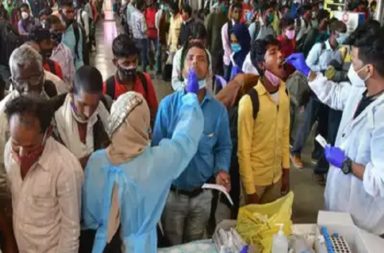Lockdown 2.0 is slated to end on May 3 and as the deadline of the lockdown nears, medical experts feel that May could be the “make or break” month for the fight against COVID-19. It is now essential to follow an aggressive containment strategy for hotspots areas while giving some relaxations to the green zones.
According to experts, railways, air travel, inter-state bus services, malls, shopping complexes, religious places, among others, should be kept shut at least for May.
On Monday, Prime Minister Narendra Modi told chief ministers that the country will now have to focus on the economy as well. We have to give importance to the economy while continuing the fight against coronavirus.
On Wednesday, the centre hinted that the ongoing nationwide lockdown will be extended beyond May 3 and the extension will be with “considerable relaxations” to people and services in “many districts”.
Experts Suggestion
Experts believe that there is a need for an aggressive containment strategy in red zones and green zones must still continue to be insulated along with relaxations.
The COVID-19 hotspots in India have come down to 129 from 170 a fortnight ago. The number of infection-free districts or green zones too have decreased from 325 to 307 as per official sources. Amid this, the number of non-hotspot districts also called as orange zones step up from 207 to 297, they added.
Dr Rajesh Kumar Gupta, Additional Director, Pulmonology and Critical Care, Fortis Noida, said it is important to understand that the lockdown does not kill the virus, it only slows the spread.
The lockdown should be continued in red zones for about two weeks or more. The curbs should be lifted in green zones while ensuring that there is no intermingling between them.
May could be a deciding month
May could be a deciding month for COVID-19 fight. It could be the “make or break” month for the fight against COVID-19. It’s important to keep a check on in places where cases are being reported.
It is important that railways, air services, interstate bus services, malls, shopping complexes, religious places etc., should be kept shut said Dr Arvind Kumar, a noted lung surgeon at Sir Ganga Ram Hospital.
Green zone districts border should remain sealed. Limited activities be allowed while ensuring social distancing with hand washing. Wearing of masks being part of people’s lifestyle, he added.
The lockdown should continue in districts reporting new cases, until such a time when there is a downward trend.
Kumar also adds that India is doing well until now and it is important to keep the cases in check. An aggressive containment strategy is the need of the hour in red zones while cautious should be observed in lifting curbs in green zones.
Dr Rommel Tickoo, Associate Director, Internal Medicine, Max Healthcare, said any major relaxation at this juncture of the fight against COVID-19 could be “disastrous”. He recommended that restrictions should remain in place at least for one more month.
“I would say lockdown should be in place for at least four more weeks. Numbers are increasing so it is not the time to remove it. Some economic activity can be allowed in green zones, but we have to be very careful,” he asserted.
India is in a better stage than other countries
India is doing better than the US and other western countries. But Prime Minister Modi has cautioned against complacency.
According to official data, India seems to have done relatively better than most advanced nations. At the 1,000 deaths benchmark, India had registered 31,332 cases, while Italy (15,113), UK (17,089), France (22,304), Spain (21,571) and Belgium (15,348), had registered lesser cases.
This shows that India’s death rate, the number of deaths concerning the number of cases, remains low.
India is doing well while keeping a check on the increasing rate of doubling of cases. It took three days when cases increased from 2,000 to 4,000. And went up to 10 days in doubling of cases from 16,000-32,000.
India has the best rate of doubling of cases from 16,000-32,000 when compared with the US, Italy, Spain, France, Germany and the UK.
Niti Aayog Tweeted
The government has already identified 15 districts in nine states, including Delhi, Maharashtra and Gujarat, as having “high caseload”.
“These 15 districts are critical in our battle against COVID-19. Of them, 7 show particularly high case volumes. India’s success in battling COVID-19 is dependent on them. We must aggressively monitor, contain, test, treat in these districts! We must win here,” Niti Aayog CEO Amitabh Kant tweeted on Monday.
These 15 districts are critical in our battle against #Covid_19 Of them 7 show particularly high case volumes. India’s success in battling COVID-19 is dependent on them. We must aggressively monitor, contain, test, treat in these districts! We must win here. pic.twitter.com/QDFvvza6iM
— Amitabh Kant (@amitabhk87) April 27, 2020





